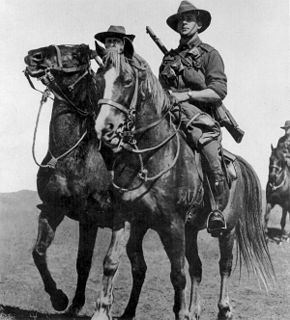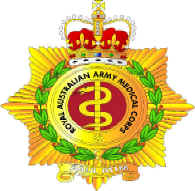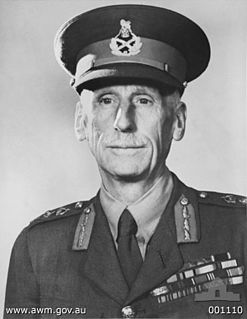Corps is a term used for several different kinds of organisation. A military innovation by Napoleon, the formation was first named as such in 1805.

Australian Light Horse were mounted troops with characteristics of both cavalry and mounted infantry, who served in the Second Boer War and World War I. During the inter-war years, a number of regiments were raised as part of Australia's part-time military force. These units were gradually mechanised either before or during World War II, although only a small number undertook operational service during the war. A number of Australian light horse units are still in existence today.

The First Australian Imperial Force was the main expeditionary force of the Australian Army during World War I. It was formed as the Australian Imperial Force on 15 August 1914, following Britain's declaration of war on Germany, initially with a strength of one infantry division and one light horse brigade. The infantry division subsequently fought at Gallipoli between April and December 1915, being reinforced by a second division which was later raised, as well as three light horse brigades. After being evacuated to Egypt the AIF was expanded to five infantry divisions, which were committed to the fighting in France and Belgium along the Western Front in March 1916. A sixth infantry division was partially raised in 1917 in the United Kingdom, but was broken up and used as reinforcements following heavy casualties on the Western Front. Meanwhile, two mounted divisions remained in the Middle East to fight against Turkish forces in the Sinai and Palestine.

The Royal Military College, Duntroon, also known simply as Duntroon, is the Australian Army's officer training establishment. It was founded at Duntroon, in Canberra, Australian Capital Territory, in 1911 and is at the foot of Mount Pleasant near Lake Burley Griffin, close to the Department of Defence headquarters at Russell Hill. It is comparable to the United Kingdom's Royal Military Academy Sandhurst and the United States Military Academy at West Point. Duntroon is adjacent to the Australian Defence Force Academy (ADFA), which is Australian Defence Force's tri-service military academy that provides military and tertiary academic education for junior officers of the Australian Army, Royal Australian Air Force and the Royal Australian Navy.

The Royal Australian Armoured Corps (RAAC) is a corps of the Australian Army which provides the Australian Defence Force's armour capability. Armour combines firepower, mobility, protection and networked situational awareness to generate shock action and overmatch in close combat. Armour is an essential element of the combined arms approach that is employed by the Australian Army.

The Royal Australian Army Medical Corps (RAAMC) is the branch of the Australian Army responsible for providing medical care to Army personnel. The AAMC was formed in 1902 through the amalgamation of medical units of the various Australian colonies and was first deployed to South Africa as a small detachment of personnel supporting the Australian Commonwealth Horse during the Second Boer War. The corps has participated in every Australian Army operation since then, including wars and peacekeeping operations. The "Royal" prefix was granted in 1948.

The Royal Army Veterinary Corps (RAVC), known as the Army Veterinary Corps (AVC) until it gained the royal prefix on 27 November 1918, is an administrative and operational branch of the British Army responsible for the provision, training and care of animals. It is a small corps, forming part of the Army Medical Services.

The Army Medical Department of the U.S. Army (AMEDD), formerly known as the Army Medical Service (AMS), encompasses the Army's six medical Special Branches. It was established as the "Army Hospital" in July of 1775 to coordinate the medical care required by the Continental Army during the Revolutionary War. The AMEDD is led by the Surgeon General of the U.S. Army, a lieutenant general.

General Sir Cyril Brudenell Bingham White,, more commonly known as Sir Brudenell White or C. B. B. White, was a senior officer in the Australian Army who served as Chief of the General Staff from 1920 to 1923 and again from March to August 1940, when he was killed in the Canberra air disaster.

The Rising Sun badge, also known as the General Service Badge or the Australian Army Badge, is the official insignia of the Australian Army, and is mostly worn on the brim of a slouch hat or, less frequently, on the front of a peaked cap for Army personnel filling certain ceremonial appointments. The badge is readily identified with the spirit of ANZAC, the legend of the Australian soldier, and the esprit de corps of the Army itself, due to its association with the landings at Gallipoli in 1915. Today, new recruits receive the badge with their initial issue of equipment, which happens within their first three days of enlistment.

The Royal Australian Engineers (RAE) is the military engineering corps of the Australian Army. The RAE is ranked fourth in seniority of the corps of the Australian Army, behind the Staff Cadets, Armoured and Artillery Corps. The corps was formed by the amalgamation of the various colonial engineer corps of the states and territories of Australia in 1902 and since then has served in various conflicts including World War I, World War II and the Vietnam War. The corps has also served on numerous peacekeeping operations and was heavily involved in the Australian contribution to the war in Afghanistan.

The Royal Australian Army Dental Corps (RAADC) is a corps within the Australian Army. It was formed on 23 April 1943 during World War II as the Australian Army Dental Corps, before being granted the 'Royal' prefix in 1948. Prior to its formation dentists were part of the Australian Army Medical Corps. The role of the RAADC is to provide dental care to army personnel in order to minimise the requirement for the evacuation of dental casualties, to conserve manpower and to reduce the burden of casualty evacuation. In the post-war years, the corps has provided personnel to deployments in Japan, Korea and Vietnam. It has also contributed to peace-keeping operations in Somalia, Rwanda, Bougainville and East Timor.

Lieutenant General Sir Alwyn Ragnar Garrett, KBE, CB was a senior commander in the Australian Army. He served as Chief of the General Staff (CGS) from 1958 to 1960.

Major General Ronald Nicholas Lamond Hopkins CBE was a senior officer in the Australian Army. He began his military career in 1915 when he entered the Royal Military College, Duntroon as a staff cadet and graduated as a lieutenant in the Permanent Forces in late 1917. Following this, he was deployed overseas and subsequently served in the Sinai and Palestine Campaign during the First World War. During the inter war years, Hopkins undertook a variety of regimental and staff positions in Australia, India and the United Kingdom. During the Second World War, he was promoted several times, briefly commanding the 7th Division Cavalry Regiment and was deployed to the Middle East before returning to Australia to undertook further staff positions. In this role he played a key role in organising the Australian Armoured Corps before later serving as a liaison officer to American forces taking part in the New Guinea campaign. Following the war, Hopkins commanded the 34th Brigade in Japan, before finishing his career as Commandant of the Royal Military College, Duntroon. In retirement he wrote a comprehensive history of the Royal Australian Armoured Corps before he died in 1990 at the age of 93.

The Australian Army was the largest service in the Australian military during World War I. The First Australian Imperial Force (AIF) was the Army's main expeditionary force and was formed from 15 August 1914 with an initial strength of 20,000 men, following Britain's declaration of war on Germany. Meanwhile, the separate, hastily raised 2,000-man Australian Naval and Military Expeditionary Force (AN&MEF), landed near Rabaul in German New Guinea on 11 September 1914 and obtained the surrender of the German garrison after ten days; it later provided occupation forces for the duration of the war. In addition, small military forces based on the pre-war Permanent Forces and part-time Citizen Forces were maintained in Australia to defend the country from attack.
The Australian Instructional Corps (AIC) was a corps of the Australian Army that existed between 1921 and 1955. Tasked with providing training to soldiers serving in Australia's part-time military force, the corps consisted of Permanent force warrant officers and senior non commissioned officers from all arms of service, who were posted to Citizen Force units as cadre staff, filling various regimental and training appointments. During the Second World War, the majority of the corps' personnel were transferred to the Second Australian Imperial Force, and in the aftermath of the war the corps eventually became part of the fledgling Australian Regular Army. In the post-war years, as the focus of Australia's defence strategy shifted towards the maintenance of a strong Regular force, the corps' role declined and it was eventually disbanded in 1955.

Major General Charles Edward Maurice Lloyd, CBE was a senior officer in the Australian Army. Lloyd graduated from the Royal Military College, Duntroon in 1918 as a regular officer in the artillery and subsequently served in a range of staff and regimental positions in the inter-war years. He later saw service in the Second World War, during which he held senior staff and administrative positions in the Middle East, the Netherlands East Indies, Papua and Australia. Later he worked as a newspaper executive, as chief of several United Nations agencies, and in private enterprise. Lloyd died in 1956.

The structure of the Australian Army during World War I included a small force of mostly militia which served in Australia and larger expeditionary forces which were raised for deployment overseas following the outbreak of the conflict in August 1914. The home army consisted of the small regular Permanent Forces, the part-time Citizen Forces, and the Australian Garrison Artillery, which were maintained in Australia to defend the country from attack, while expeditionary forces consisted of the Australian Naval and Military Expeditionary Force (AN&MEF) which occupied German New Guinea from September 1914, and the Australian Imperial Force (AIF) which fought at Gallipoli in 1915, and in the Middle East and on the Western Front in Europe from 1916 to 1918. Following an initial precautionary mobilisation following the outbreak of war, by the end of August 1914 those units of the reserve formations of the home army that had been activated began to stand down. From 1915, only skeleton garrisons were maintained at coastal forts. Meanwhile, as the war continued overseas the AIF sustained heavy losses, and although it expanded considerably during the war, with the voluntary recruitment system unable to replace its casualties by 1918 most of its units were significantly undermanned.
The uniforms of the Australian Army have changed significantly over the past century, although the accoutrements worn over this period have remained relatively similar. The forces of the Australian colonies and the early forces of the Commonwealth post-Federation in 1901 closely followed the uniforms of the British Army. Since then it has continued to be influenced by British but also US styles, as well as including some distinctly Australian designs, reflecting local conditions and trends.
















